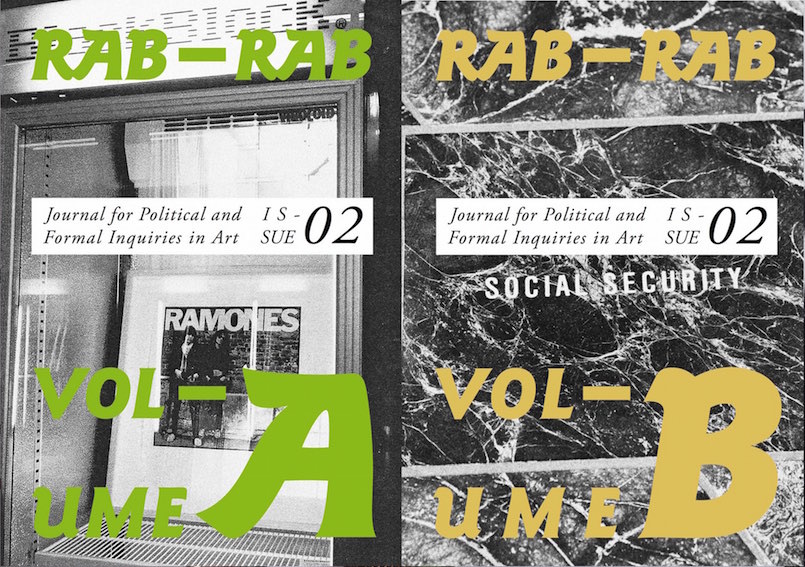Rab-Rab: Journal for Political and Formal Inquiries in Art, 2 (2015)
Filed under magazine | Tags: · art history, avant-garde, film, futurism, music, music criticism, noise

“The second issue of Rab-Rab is in two volumes, all together in 500 pages. The focus of the second issue is ‘noise against culture.’ The contributions deal with the formal theory of noise, politics of contradictions, the device of estrangement, materialist film, music and violence, Futurism, Russian avant-garde, improvisation, void, heterophonies, swearwords, communism, ideologies of marriage, class wars and electricity.
Departing from our programme based on the understanding of art practice as a confrontation between formal and political inquiries, our aim in this issue is to use noise as the name for this difficult, disturbing, loud and coercive exploration. In many cases the formal and political aspects of noise are two separate things: the former is seen as an issue of information or perception, whereas the latter is usually reduced to a metaphor of spontaneity. But if we change these parameters of discussing the noise from measurable coefficients of failed communication, or from elusive metaphors of contingencies, towards the conceptual references related to ideology and class struggles, then what is understood as noise turns into something else. It can become a valid concept of inquiry, refusing to be pinpointed to conventional academic banalities silly phenomenological artistic fantasies immersed in.”
Contributors to volume A: Dror Feiler, Mazen Kerbaj, Ozren Pupovac, Ben Watson, Michel Chevalier, Jean-Claude Moineau, Taneli Viitahuhta, Henrik Heinonen, Grégoire Rousseau, Bruno Besana, Ivana Momčilović, and François Nicolas.
Contributors to volume B: Darko Suvin, Anthony Iles, Grupa za Konceptualnu Politiku, Mattin, Jyrki Siukonen, Rahel Puffert, Martin Krenn, Jaakko Karhunen, Max Ryynänen, Antti Eskelinen – Eze, Gert Raeithel, Aeron Bergman, Alejandra Salinas, Milica Tomić, Christine Delphy, Peter Gidal, Giovanna Esposito-Yussif, Kari Yli-Annala and Sezgin Boynik.
Edited by Sezgin Boynik
Publisher Rab-Rab Press, Helsinki, Sep 2015
ISSN 2342-4885
278 & 278 pages
Publisher (Issue 2A)
Publisher (Issue 2B)
Issue 2A: PDF, PDF
Issue 2B: PDF, PDF
Marc James Léger (ed.): The Idea of the Avant Garde: And What It Means Today (2014)
Filed under book | Tags: · activism, aesthetics, architecture, art criticism, art history, avant-garde, film, intermedia, literature, music, performance, photography, theatre

“This book is premised on the view that the idea of the avant garde has an increased importance in these times of global political crisis. Much cultural production today is shaped by a biopolitics that construes all creative and knowledge production in terms of capital accumulation. A different kind of culture is possible. This collection of writings, essays, interviews and artworks by many of today’s most radical cultural practitioners and astute commentators on matters avant garde mediates the different strategies and temporalities of avant-garde art and politics. Tracing diverse genealogies and trajectories, the book offers an inter-generational forum of ideas that covers different arts fields, from visual art, art activism, photography, film and architecture, to literature, theatre, performance, intermedia and music.”
Texts by Marc James Léger, Adrian Piper, Andrea Fraser, David Tomas, Catherine Lescarbeau, Hal Foster, Laura Mulvey, Bruce LaBruce, Santiago Sierra, Derek Horton, Christine Wertheim, Lyn Hejinian, Marjorie Perloff, Wu Ming 2, Nikolaus Müller-Schöll, Rabih Mroué, Judith Malina, Moe Angelos, Bill Brown, The Errorist International, Jonas Mekas, Thomas Elsaesser, Alexander Kluge and Oskar Negt, Travis Wilkerson, Evan Mauro, Mikkel Bolt Rasmussen, Gene Ray, John Roberts, Zanny Begg and Dmitry Vilensky, Owen Hatherley, Michael Webb, Mitchell Joachim, Beatriz Colomina, Boris Groys, Vitaly Komar, Victor Tupitsyn, Gregory Sholette and Krzysztof Wodiczko, Critical Art Ensemble, BAVO, Alexei Monroe, Jean-Hervé Péron, Chris Cutler, Charles Gaines, Jason Robinson, Sara Marcus, Cosey Fanni Tutti, Thanos Chrysakis, Kim Cascone, Marc Couroux, Thérèse Mastroiacovo, Chrysi Papaioannou, and Bill Dane.
Publisher Manchester University Press, Manchester, with Left Curve, Oakland, CA, 2014
ISBN 9780719096914, 071909691X
285 pages
Editor
Exhibition (2018)
Publisher
WorldCat
PDF (16 MB)
Comment (0)Apparatus, 6: Women at the Editing Table: Revising Soviet Film History of the 1920s and 1930s (2018)
Filed under journal | Tags: · avant-garde, cinema, editing, film, film history, montage, women

“The construction of the historical narrative of film editing has the cultural invisibility of women and of collaborators embedded within it. Film histories regularly spend whole chapters describing editing as a significant revolution in the medium. However, while the names of “great directors” are evoked in these discussions, the names of editors are not mentioned: “…for the most part, the women who cut film in the silent era remained unacknowledged in film credits or the trade press. Their work was considered to be merely technical rather than creative.” […]
Collectively, the articles in this issue are shifting understanding of the editor’s work from ‘merely’ technical or ‘just helping’, which is a gendered erasure of women’s work, to understanding it as expert collaboration in filmmaking. In other words, creative work. Why is this important? Because by obscuring the creativity of the work of the hands of women who watched, sorted, cut and pasted frames of film together we obscure the women themselves.” (from Editorial)
Texts by Karen Pearlman, John MacKay, and John Sutton, Lilya Kaganovsky, Natalie Ryabchikova, Nikolai Izvolov, Adelheid Heftberger, and Esfir Shub.
Edited by Karen Pearlman and Adelheid Heftberger
Publisher Apparatus, Berlin, August 2018
Open access
ISSN 2365-7758

